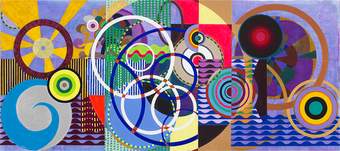
Beatriz Milhazes Maracorola, 2015. Ivor Braka Limited. Photo Manuel Águas and Pepe Schettino. © Beatriz Milhazes Studio
This summer, Tate St Ives presents Maresias, a major exhibition of the work of Beatriz Milhazes (b.1960, Rio de Janeiro), one of the leading abstract artists working today. The exhibition celebrates the evolution of her approach over four decades, while also highlighting nature as an enduring and increasingly important theme in her work. Turner Contemporary, who first staged Maresias, have collaborated with Tate St Ives to reimagine the exhibition to be seen this summer in Cornwall, bringing it to a second UK coastal destination.
Maresias refers to the salty sea breeze that is part of Milhazes’s everyday life in the coastal city of Rio de Janeiro. The exhibition encourages us to reflect on our own relationship to the environment. Milhazes says, ‘my context has been surrounded by forests, mountains and coastal experiences; the development of a 'tropical' way of thinking. It was very special to exhibit my work at Turner Contemporary and now at Tate St Ives - to smell the sea salt breeze of the same ocean as Rio de Janeiro. Same water, different cultures, but in the end it is all about life.’
Milhazes emerged in the 1980s as a leading figure in the important Brazilian art movement Geração Oitenta (1980s Generation), which moved away from the austere conceptual art of the previous decade and embraced painting as a form of energy and expression. Known for intensely colourful, large-scale abstract canvases which present energetic contradictions, Milhazes’s careful and deliberate compositions have the appearance of spontaneity. Slick surfaces conceal small details of cracks and layers, which signify the importance of history and memory to her painting process.
The exhibition will take the viewer through a journey of Milhazes’s work since 1989; a breakthrough moment for Milhazes when, frustrated by the appearance of brushstrokes, which she saw as signs of the artist’s hand, she developed her distinctive ‘monotransfer’ technique in which she paints her own motifs onto plastic sheeting before transposing them onto canvas. This process offers the possibility to retain the fidelity of the colours and intensify the effects of fluorescent and metallic pigments. It also allows Milhazes to create a smooth and defiant surface without losing the painterly quality, from which she can build her images, adapting the concept of collage to her painting practice. Expansive paintings and denser compositions such as Maresias 2002, some of which were shown in the Brazilian Pavilion at the 50th Venice Biennale – show how Milhazes has expanded and refined the monotransfer technique, characterised by geometric shapes, arabesque lines and dazzling colour. In her words, ‘geometry organizes my thought and imagination; I've been interested in the relation between nature and mathematics. My creative process is very rational, with an imaginary logic, built up as equations, thinking about the structure of nature and the history of art.’
Milhazes is influenced by multiple sources including Brazilian and European modernism, Catholic iconography, Baroque colonial architecture, and the vernacular culture and heritage of Brazil. Her work reveals her relation to applied arts from where she has taken inspiration for her motifs such as abstracted flowers, oceans, trees, plants, suns and stars. Milhazes’s more pronounced use of forms including waves, petals and circles have come to characterise her distinctive visual language.
Milhazes also looks to her city’s context, its vibrant culture and social contrasts for inspiration, as well as the spiritual experience of being in nature, The Tijuca forest, Copacabana beach and Rio de Janeiro’s Botanical Gardens. References to art, architecture and popular culture are layered upon one another, reflecting her fascination with the ‘high low’ and the hybridity of everyday life in Brazil.
Milhazes, who has a background in early years education, will be leading workshops with a local primary school in the area during the exhibition at Tate St Ives.
